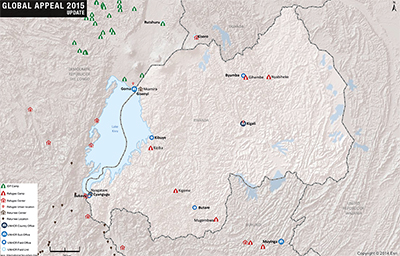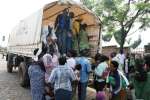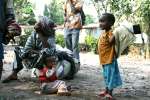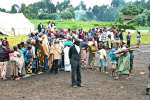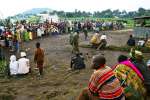Home > Where We Work > Africa > Central Africa and the Great Lakes > Rwanda
2015 UNHCR country operations profile - Rwanda
| Overview |
Working environment
-
The Central Africa and Great Lakes subregion is fraught with multiple conflicts and political instability. In addition to the crisis in the Central African Republic which has affected many countries in the subregion, the precarious security situation in the Democratic Republic of the Congo (DRC) has also seen large-scale refugee movements into Rwanda and other neighbouring countries.
-
Rwanda has been hosting refugees, mainly from the DRC, but also from other African countries, for decades. The majority of the refugees are hosted in five camps - Gihembe, Kigeme, Kiziba, Mugombwa and Nyabiheke. In 2015, UNHCR will continue providing protection and assistance to refugees and asylum-seekers.
-
Over the past few years, thousands of refugees have returned to Rwanda and another 10,000 are expected to do so in 2015. UNHCR is active in a joint Government and One UN return and reintegration programme for Rwandan returnees, which provides a platform for all stakeholders to coordinate their activities.
-
With a country target of 10,000 resettled refugees, Rwanda is part of UNHCR's regional comprehensive solutions strategy for Congolese refugees in the Great Lakes region.
-
The Rwandan Government makes land available for refugee camps and facilitates access for refugees to public services, particularly the educational system. To ensure that refugee students are enrolled in upper secondary education, UNHCR will support the construction of additional schools for some 4,800 students.
People of concern
In 2015, UNHCR's Rwanda operation will support: some 50,000 refugees who fled the DRC in the mid-1990s, and over 30,000 new arrivals from eastern DRC since April 2012 escaping from armed clashes between government forces and non-state groups; and returnees who have come back since 2002, mainly from the DRC.
| UNHCR 2015 planning figures for Rwanda | |||||
|---|---|---|---|---|---|
| Type of population | Origin | January 2015 | December 2015 | ||
| Total in country | Of whom assisted by UNHCR |
Total in country | Of whom assisted by UNHCR |
||
| Total | 97,340 | 97,340 | 105,340 | 105,340 | |
| Refugees | Burundi | 340 | 340 | 340 | 340 |
| Chad | 10 | 10 | 10 | 10 | |
| Dem. Rep. of the Congo | 84,640 | 84,640 | 94,640 | 94,640 | |
| Various | 20 | 20 | 20 | 20 | |
| Asylum-seekers | Burundi | 30 | 30 | 30 | 30 |
| Dem. Rep. of the Congo | 180 | 180 | 180 | 180 | |
| Returnee arrivals during year (ex-refugees) | Rwanda | 12,000 | 12,000 | 10,000 | 10,000 |
| Others of concern | Burundi | 10 | 10 | 10 | 10 |
| Dem. Rep. of the Congo | 90 | 90 | 90 | 90 | |
| Rwanda | 30 | 30 | 30 | 30 | |
| Response |
Needs and strategies
In 2015, issuing birth certificates to all newborns will remain a priority as currently there is a backlog of 18,000 birth certificates. Refugees aged 16 years and over will require ID cards. Machine-readable Convention Travel Documents will also be issued to refugees starting from 2015.
In Rwanda, 12 years of free education for children is mandatory. A UNHCR agreement with the Government allows refugee children to enrol in the national educational system. In 2015, additional classrooms will increase the absorption capacity of local schools.
Meanwhile, problems caused by soil erosion in Gihembe camp remain a concern as there have been several tragic accidents. In all camps, soil erosion and landslides during the rainy season are a major challenge. Costly structural modifications, such as the construction of drainage systems and terracing, and the planting of trees, need to be implemented. An estimated USD 1.5 million is required to address the situation.
Regarding water, sanitation and hygiene facilities, pit latrines need to be replaced with dischargeable latrines by the end of 2015. Between 2012 and 2014, 90 latrines were constructed and 440 more are needed.
UNHCR will advocate for refugees to be enrolled into the Rwandan public health system. Local health structures need to be equipped to absorb this extra demand.
In the camps, people receive an average of just 12 litres of water per day, as the landscape and infrastructure of Gihembe and Mugombwa camps require water to be deviated from sources located approximately 15 and 28 kilometres away, respectively.
| Implementation |
Coordination
In 2015, UNHCR will continue its close collaboration with the Government of Rwanda and UN agencies, under the framework of the Delivering as One initiative.
UNHCR will also contribute to the Peace, Security and Cooperation Framework for the Democratic Republic of the Congo and the Region, providing continuous support to the Office of the Special Envoy of the Secretary-General for the Great Lakes Region of Africa and other participating institutions and organizations.
In order to ensure the protection of people of concern in Rwanda and the delivery of adequate services, UNHCR will rely on its partnerships with government institutions, particularly the Ministry for Disaster Management and Refugees (MIDIMAR) and partners delivering services to refugees.
| 2015 UNHCR partners in Rwanda |
|---|
| Implementing partners |
| Government agencies: Ministry of Disaster Management and Refugee Affairs |
| NGOs: Adventist Development and Relief Agency, Africa Humanitarian Action, American Refugee Committee, Parlement des Jeunes Rwandais, Plan International, World Vision |
| Operational partners |
| FAO, IFAD, ILO, IOM, ITC, UNAIDS, UNCTAD, UNDP, UNECA, UNEP, UNESCO, UNIDO, UNFPA, UN-Habitat, UNICEF, UNV, UN Women, WFP, WHO |
| Financial information |
Following the steady influx of refugees from the DRC,the financial requirements of the Rwanda operation have gradually increased from USD 22.6 million in 2010 to USD 52 million in 2014. This took into consideration the initial costs for developing the newly-created camp of Mugombwa. Fewer refugee arrivals in 2014 have led to setting the 2015 budget at USD 43.2 million.
Source: UNHCR Global Appeal 2015 Update

